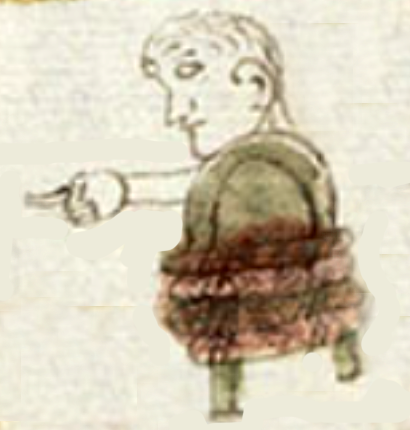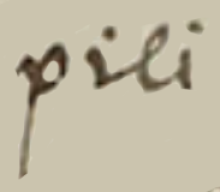pilli (CST34)
This painting of the simplex glyph for the term pilli (nobleman) shows a man in profile, facing toward the viewer’s left. His right arm juts forward, and he is pointing his index finger (mapilli) right at a mandamiento (order or ruling), which may refer to the authority embedded in such a document. Or perhaps the finger is a phonetic complement to underline the term pilli and its authority, given that this gesture could be a sign of his nobility. He wears something that looks like a carrying frame on his left side. The device seems to be one piece of wood that is curved at the top and has two posts that hang down, almost to the ground. Three or four horizontal bars of some sort, typically of different colors, attach to these two posts at about waist height and rest against the human body.
Stephanie Wood
Not all pipiltin (the plural of pilli) in this manuscript wear one of these devices. Kevin Terraciano (Codex Sierra, 2021, 72, Fig. 3.2) suggests that this is not a carrying frame but a device worn around the neck, which is clearer in the example that appears on plate 41. Both here and on plate 41 the men in question went to get documents from Mexico City, so perhaps this device is something like a briefcase that was made for carrying important papers.
Stephanie Wood
1550–1564
Jeff Haskett-Wood
nobles, puntar, mano, dedo, gobierno, viajar, Ciudad de México, papeles, huirse, congregación, documentos legales, mapilhuia, mahpilhuia, señalar con el dedo

pilli, nobleman, https://nahuatl.wired-humanities.org/content/pilli
mapilhuia, to point a finger, https://nahuatl.wired-humanities.org/content/mapilhuia
un noble
Stephanie Wood
Códice Sierra-Texupan, plate 34, page dated 1560. Origin: Santa Catalina Texupan, Mixteca Alta, State of Oaxaca. Kevin Terraciano has published an outstanding study of this manuscript (Codex Sierra, 2021), and in his book he refers to alphabetic and “pictorial” writing, not hieroglyphic writing. We are still counting some of the imagery from this source as hieroglyphic writing, but we are also including examples of “iconography” where the images verge on European style illustrations or scenes showing activities. We have this iconography category so that such images can be fruitfully compared with hieroglyphs. Hieroglyphic writing was evolving as a result of the influence of European illustrations, and even alphabetic writing impacted it.
https://bidilaf.buap.mx/objeto.xql?id=48281&busqueda=Texupan&action=search
The Biblioteca Digital Lafragua of the Biblioteca Histórica José María Lafragua in Puebla, Mexico, publishes this Códice Sierra-Texupan, 1550–1564 (62pp., 30.7 x 21.8 cm.), referring to it as being in the “Public Domain.” This image is published here under a Creative Commons license, asking that you cite the Biblioteca Digital Lafragua and this Visual Lexicon of Aztec Hieroglyphs.



